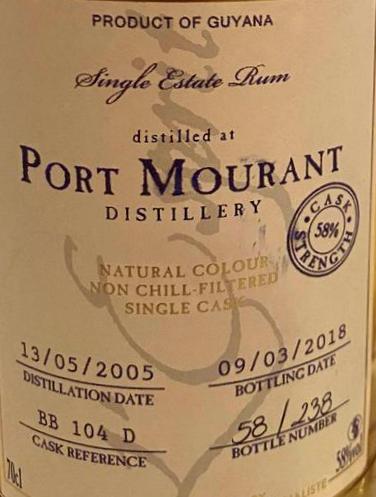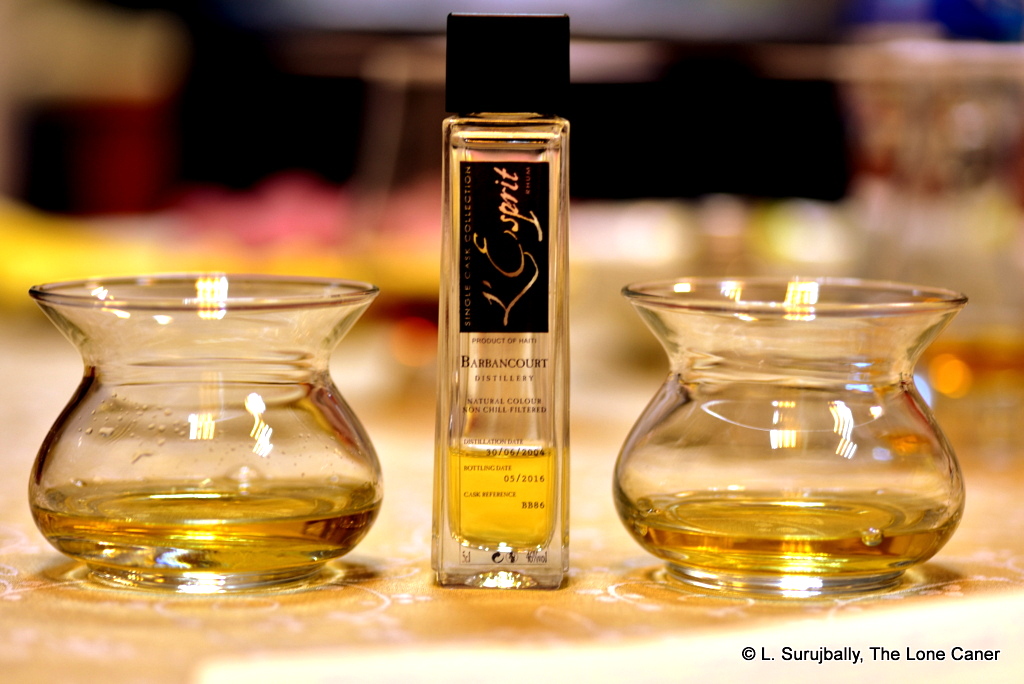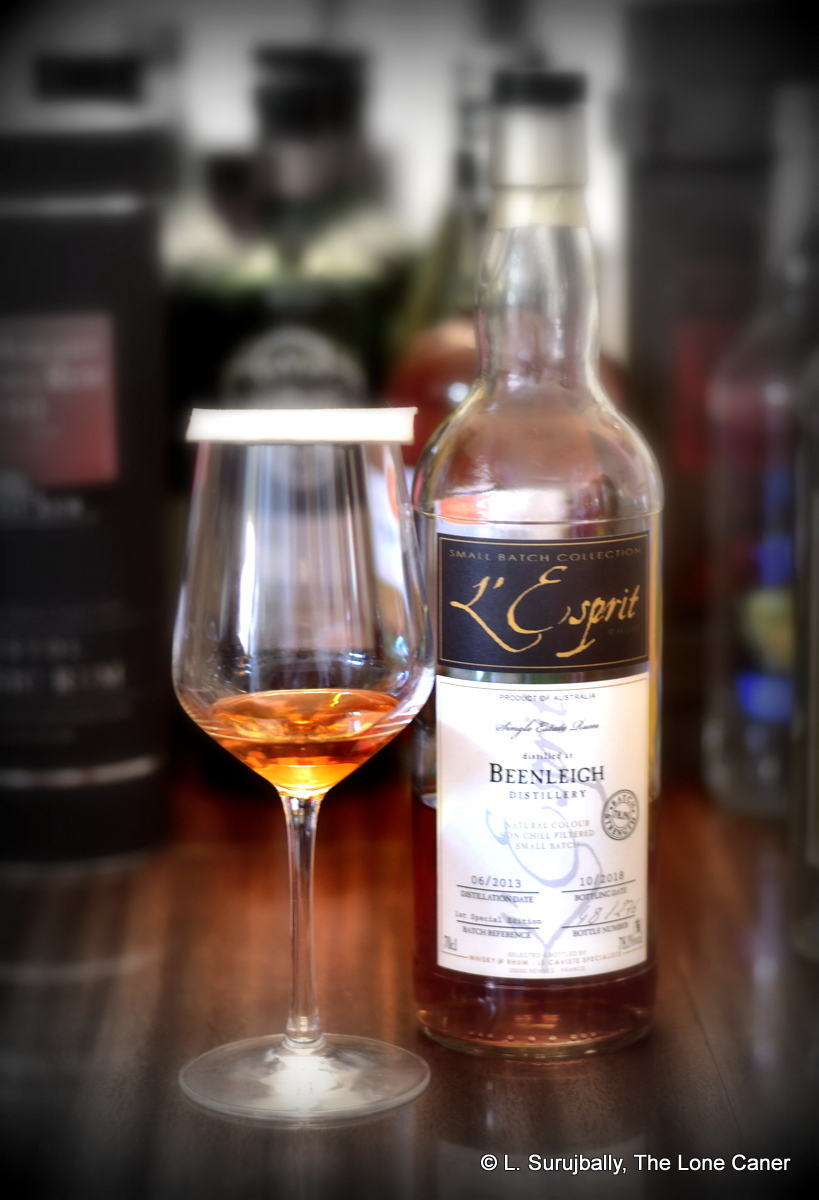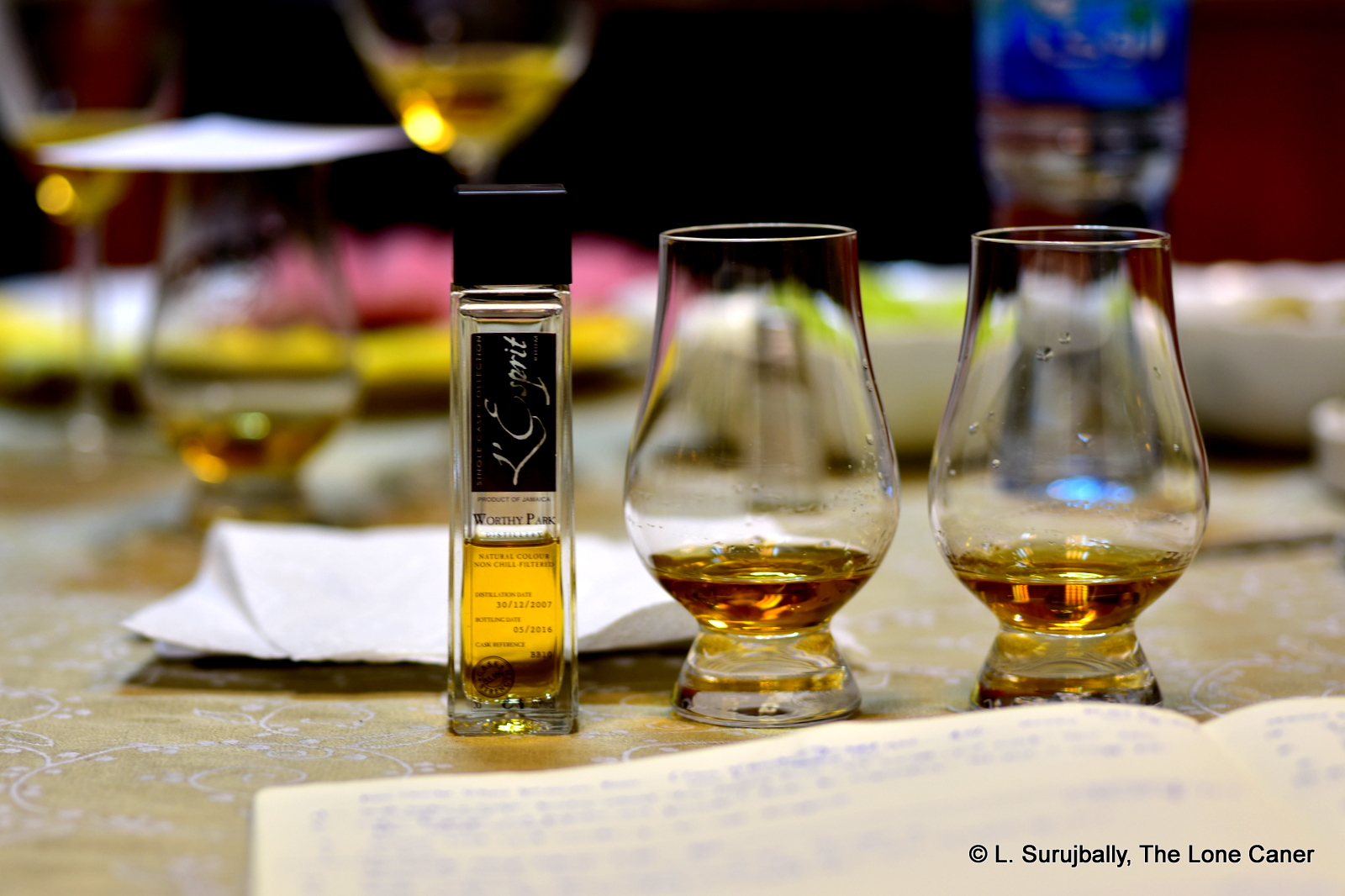 It’s not entirely clear why the little Brittany-based independent bottler L’ESprit – for which I have retained an enormous fondness over the years – advertises so little and keeps such a low profile. One never sees them at rum festivals, Tristan Prodhomme is practically unknown among the pantheon of small-company personalities, the company is more wedded to whisky than to rum…and yet the rums this one little outfit does release have a really good track record, people do treasure the ones they get and I would always take a second look myself, if one crossed my path: it’s one of the few indies whose wares I actively seek out and keep an eye open for.
It’s not entirely clear why the little Brittany-based independent bottler L’ESprit – for which I have retained an enormous fondness over the years – advertises so little and keeps such a low profile. One never sees them at rum festivals, Tristan Prodhomme is practically unknown among the pantheon of small-company personalities, the company is more wedded to whisky than to rum…and yet the rums this one little outfit does release have a really good track record, people do treasure the ones they get and I would always take a second look myself, if one crossed my path: it’s one of the few indies whose wares I actively seek out and keep an eye open for.
L’Esprit has, since its inception, gone through the whole gamut of what’s possible: they have released aged and unaged rums, standard strength or still strength, represented pretty much all the major rum producing countries out there (and a few minor ones), and in a nice touch, sometimes issue the same rum at two different strengths – standard and full proof. Today’s rum comes from Foursquare: it’s the usual pot-column blend characteristic of the famed distillery, distilled in November 2005, bottled in October 2020 (so a neat 15 years old), 60.5% and as far as I know, aged in ex-bourbon barrels.
 From those stats you can guess it’s a rum of furious and tasty brutality, and that’s not far off. The nose lunges from the bottle in an initial attack of pungent nutty and fruity notes, very intense. It is, one should note in passing, extremely nice too; it follows up with an uppercut of caramel, salt, acetones and the boiling scent of an “under final touch ups” stage of a new house in the hot summer — acetones, plastic turpentine and floor wax (clearly more pot still in action here). Then it seems to want to calm down and more restrained aromas come through – strawberries, unsweetened chocolate, tinned fruit syrup, dark honey, leather and port infused damp tobacco. That’s quite a lot for any rum to be providing, no matter who makes it.
From those stats you can guess it’s a rum of furious and tasty brutality, and that’s not far off. The nose lunges from the bottle in an initial attack of pungent nutty and fruity notes, very intense. It is, one should note in passing, extremely nice too; it follows up with an uppercut of caramel, salt, acetones and the boiling scent of an “under final touch ups” stage of a new house in the hot summer — acetones, plastic turpentine and floor wax (clearly more pot still in action here). Then it seems to want to calm down and more restrained aromas come through – strawberries, unsweetened chocolate, tinned fruit syrup, dark honey, leather and port infused damp tobacco. That’s quite a lot for any rum to be providing, no matter who makes it.
 Clearly slowing down is not in this bottle’s bag of tricks: it continues to go strongly, like a bat out of hell, on this and every subsequent tasting (the glass is with me for the best part of a full day): it’s sweet, dry, aromatic, tasty. Green peas, syrup again, pears, stewed apples, tinned peaches, which is all pretty much what one could expect. But it does have some kinks as well, tastes that are somewhat odd — pleasant enough but almost unfamiliar, the way these components come together. Plastic, kerosene (just a touch), balsamic vinegar, mangoes in a very hot pepper sauce, that kind of thing. The edge and savagery is always just behind the sweet and more aromatic side of the profile, waiting to pounce if you treat it with anything less than respect. It all leads to a medium short finish (which, admittedly, is surprising for something that has to this point been going full steam), with not a whole lot more. Fleshy stoned fruits, some caramel and vanilla, strawberries, and the glue and wax make a short bow before scampering back offstage.
Clearly slowing down is not in this bottle’s bag of tricks: it continues to go strongly, like a bat out of hell, on this and every subsequent tasting (the glass is with me for the best part of a full day): it’s sweet, dry, aromatic, tasty. Green peas, syrup again, pears, stewed apples, tinned peaches, which is all pretty much what one could expect. But it does have some kinks as well, tastes that are somewhat odd — pleasant enough but almost unfamiliar, the way these components come together. Plastic, kerosene (just a touch), balsamic vinegar, mangoes in a very hot pepper sauce, that kind of thing. The edge and savagery is always just behind the sweet and more aromatic side of the profile, waiting to pounce if you treat it with anything less than respect. It all leads to a medium short finish (which, admittedly, is surprising for something that has to this point been going full steam), with not a whole lot more. Fleshy stoned fruits, some caramel and vanilla, strawberries, and the glue and wax make a short bow before scampering back offstage.
And that’s it. It’s the sort of neat pour that will leave you gasping a bit but also pleased to have been able to finish it. Overall it’s solid, and easily buffs the credentials of both producer and bottler to a brighter gleam. It has a seriously good nose with everything we like included, which is then sanded to a shine and bolted on to an anvil-heavy series of tasting notes that don’t seek to reinvent the wheel (or Foursquare), but simply present the best of which this particular barrel is capable. It’s like Tristan found a barrel he liked so much that it was only by the most supreme effort of will that he didn’t slap an ECS label on it – because that’s the only thing I can compare it to, and that’s what it really is. I call mine “Truculentus”.
(#1061)(86/100) ⭐⭐⭐⭐










 The French-bottled, Australian-distilled Beenleigh 5 Year Old Rum is a screamer of a rum, a rum that wasn’t just released in 2018, but unleashed. Like a mad roller coaster, it careneed madly up and down and from side to side, breaking every rule and always seeming just about to go off the rails of taste before managing to stay on course, providing, at end, an experience that was shattering — if not precisely outstanding.
The French-bottled, Australian-distilled Beenleigh 5 Year Old Rum is a screamer of a rum, a rum that wasn’t just released in 2018, but unleashed. Like a mad roller coaster, it careneed madly up and down and from side to side, breaking every rule and always seeming just about to go off the rails of taste before managing to stay on course, providing, at end, an experience that was shattering — if not precisely outstanding. I still remember how unusual the
I still remember how unusual the 
 Whatever the case, the rum was as fierce as the Diamond, and even at a microscopically lower proof, it took no prisoners. It exploded right out of the glass with sharp, hot, violent aromas of tequila, rubber, salt, herbs and really good olive oil. If you blinked you could see it boiling. It swayed between sweet and salt, between soya, sugar water, squash, watermelon, papaya and the tartness of hard yellow mangoes, and to be honest, it felt like I was sniffing a bottle shaped mass of whup-ass (the sort of thing Guyanese call “regular”).
Whatever the case, the rum was as fierce as the Diamond, and even at a microscopically lower proof, it took no prisoners. It exploded right out of the glass with sharp, hot, violent aromas of tequila, rubber, salt, herbs and really good olive oil. If you blinked you could see it boiling. It swayed between sweet and salt, between soya, sugar water, squash, watermelon, papaya and the tartness of hard yellow mangoes, and to be honest, it felt like I was sniffing a bottle shaped mass of whup-ass (the sort of thing Guyanese call “regular”).
 I’ll get straight to it, then, and merely mention that at 85% ABV, care was taken – I poured, covered the glass, waited, removed the cover, and prudently stepped way back.
I’ll get straight to it, then, and merely mention that at 85% ABV, care was taken – I poured, covered the glass, waited, removed the cover, and prudently stepped way back.

 What’s all the more astounding about
What’s all the more astounding about  Based on how it initially nosed, I started out believing this was a wooden still — by the end, I was no longer so sure. The profile actually reminded me more of the
Based on how it initially nosed, I started out believing this was a wooden still — by the end, I was no longer so sure. The profile actually reminded me more of the 
 So, given how many Jamaicans are on the scene these days, how does this young, continentally aged 55.9% golden rum fare? Not too shabbily. It’s strong but very approachable, even on the nose, which doesn’t waste any time getting started but announces its ester-rich aromas immediately and with authority: acetone, nail polish and some rubber plus a smell of righteous funk (spoiling fruits, rotten bananas, that kind of thing). Its relative youth is apparent in the uncouth sharpness of the initial aromas, but once one sticks with it, it settles into its own special groove, calms itself down and does a neat little balancing act between sharper scents of citrus, cider, apples, hard yellow mangoes and green grapes, and softer ones of bananas, cumin, vanilla, marshmallows and cloves.
So, given how many Jamaicans are on the scene these days, how does this young, continentally aged 55.9% golden rum fare? Not too shabbily. It’s strong but very approachable, even on the nose, which doesn’t waste any time getting started but announces its ester-rich aromas immediately and with authority: acetone, nail polish and some rubber plus a smell of righteous funk (spoiling fruits, rotten bananas, that kind of thing). Its relative youth is apparent in the uncouth sharpness of the initial aromas, but once one sticks with it, it settles into its own special groove, calms itself down and does a neat little balancing act between sharper scents of citrus, cider, apples, hard yellow mangoes and green grapes, and softer ones of bananas, cumin, vanilla, marshmallows and cloves.
 The bare statistics are brief and as follows: column still product, continentally aged; distilled 2004 and released in 2016 at a brobdingnagian 66.2% (its lesser proofed twin which is quite similar is bottled at 46% and 228 bottles were issued but about the full proof edition here, I’m not certain – less, for sure, maybe a hundred or so). Pale yellow in colour and a massive codpiece of a nose, deep and intense, which should not present as a surprise at all. It was quite aromatic as well – one could sense bananas, vanilla, prunes and fruit, with a nice counterpoint of citrus to set these off. Like many rums released at cask strength, it rewarded patience because after a while back-end smells of cream cheese, dark bread, brine, olives, nail polish, plastic bubble wrap (freshly popped), paint became much more evident, though fortunately without taking over entirely
The bare statistics are brief and as follows: column still product, continentally aged; distilled 2004 and released in 2016 at a brobdingnagian 66.2% (its lesser proofed twin which is quite similar is bottled at 46% and 228 bottles were issued but about the full proof edition here, I’m not certain – less, for sure, maybe a hundred or so). Pale yellow in colour and a massive codpiece of a nose, deep and intense, which should not present as a surprise at all. It was quite aromatic as well – one could sense bananas, vanilla, prunes and fruit, with a nice counterpoint of citrus to set these off. Like many rums released at cask strength, it rewarded patience because after a while back-end smells of cream cheese, dark bread, brine, olives, nail polish, plastic bubble wrap (freshly popped), paint became much more evident, though fortunately without taking over entirely



